Allsports Club Information System: System Analysis and Design Report
VerifiedAdded on 2023/06/03
|22
|3977
|304
Report
AI Summary
This document presents a system analysis and design report for Allsports, a multisport club, aiming to address the challenges of their current manual system. It proposes a software development methodology, specifically Extreme Programming and Rapid Application Development, and recommends RAD due to its cost-effectiveness and suitability for well-defined business requirements. The report outlines various data collection methods, including questionnaires, interviews, and focus groups, with a sample questionnaire included. Furthermore, it details the system requirements, distinguishing between functional and non-functional aspects. The report includes visual representations like class diagrams, use case diagrams, entity-relationship diagrams, data flow diagrams, and activity diagrams to illustrate the proposed information system's structure and functionality. The aim is to provide High Voltage Information Services with specifications for an information system that lists club members, sports activities, articles, adverts, newsletters, and member contact information, ultimately improving the club's operations and addressing issues like inefficiency, data duplication, and poor customer service.

Running head: SYSTEM ANALYSIS AND DESIGN 1
System Analysis and Design
Student Name
Institutional Affiliation
System Analysis and Design
Student Name
Institutional Affiliation
Paraphrase This Document
Need a fresh take? Get an instant paraphrase of this document with our AI Paraphraser
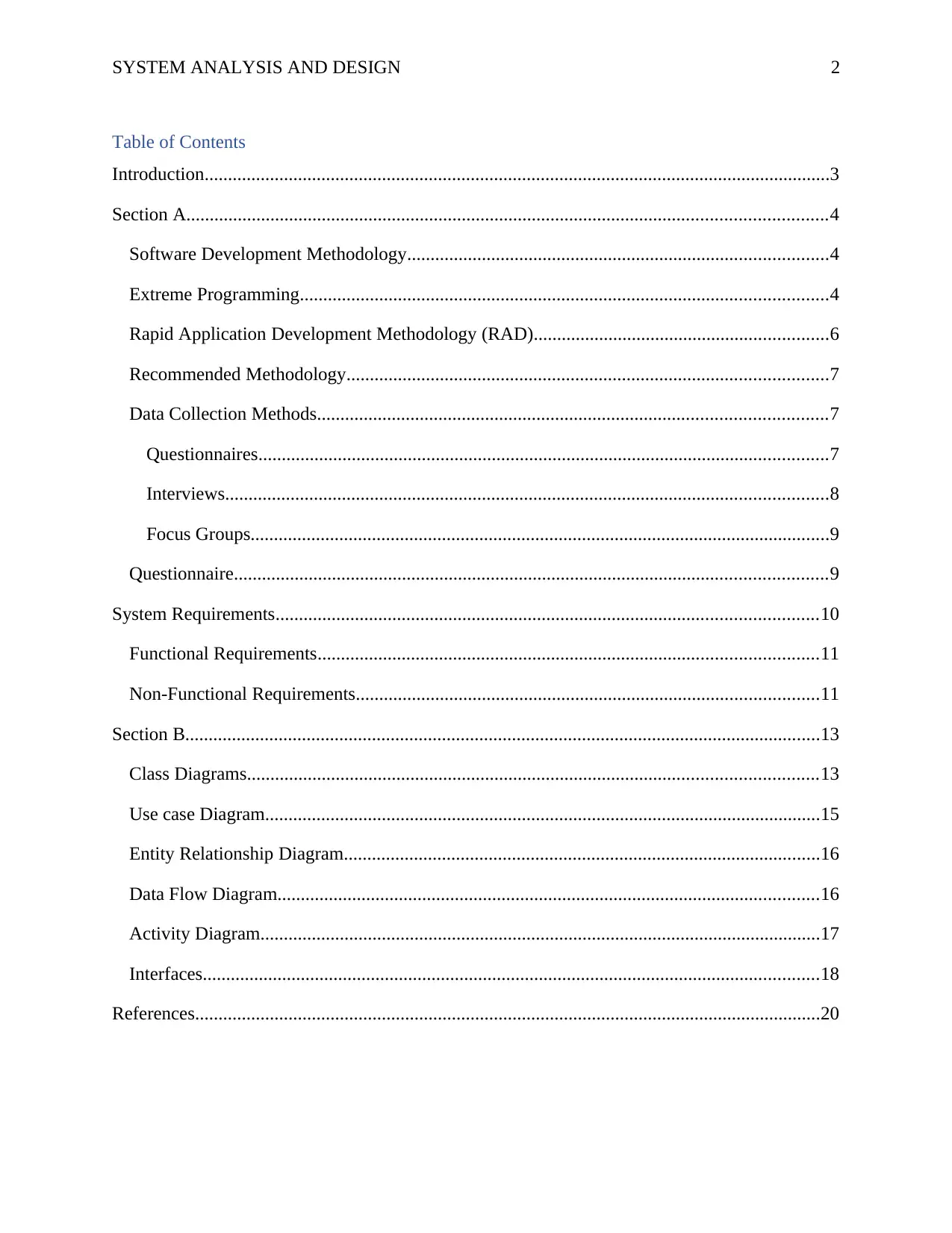
SYSTEM ANALYSIS AND DESIGN 2
Table of Contents
Introduction......................................................................................................................................3
Section A.........................................................................................................................................4
Software Development Methodology..........................................................................................4
Extreme Programming.................................................................................................................4
Rapid Application Development Methodology (RAD)...............................................................6
Recommended Methodology.......................................................................................................7
Data Collection Methods.............................................................................................................7
Questionnaires..........................................................................................................................7
Interviews.................................................................................................................................8
Focus Groups............................................................................................................................9
Questionnaire...............................................................................................................................9
System Requirements....................................................................................................................10
Functional Requirements...........................................................................................................11
Non-Functional Requirements...................................................................................................11
Section B........................................................................................................................................13
Class Diagrams..........................................................................................................................13
Use case Diagram.......................................................................................................................15
Entity Relationship Diagram......................................................................................................16
Data Flow Diagram....................................................................................................................16
Activity Diagram........................................................................................................................17
Interfaces....................................................................................................................................18
References......................................................................................................................................20
Table of Contents
Introduction......................................................................................................................................3
Section A.........................................................................................................................................4
Software Development Methodology..........................................................................................4
Extreme Programming.................................................................................................................4
Rapid Application Development Methodology (RAD)...............................................................6
Recommended Methodology.......................................................................................................7
Data Collection Methods.............................................................................................................7
Questionnaires..........................................................................................................................7
Interviews.................................................................................................................................8
Focus Groups............................................................................................................................9
Questionnaire...............................................................................................................................9
System Requirements....................................................................................................................10
Functional Requirements...........................................................................................................11
Non-Functional Requirements...................................................................................................11
Section B........................................................................................................................................13
Class Diagrams..........................................................................................................................13
Use case Diagram.......................................................................................................................15
Entity Relationship Diagram......................................................................................................16
Data Flow Diagram....................................................................................................................16
Activity Diagram........................................................................................................................17
Interfaces....................................................................................................................................18
References......................................................................................................................................20
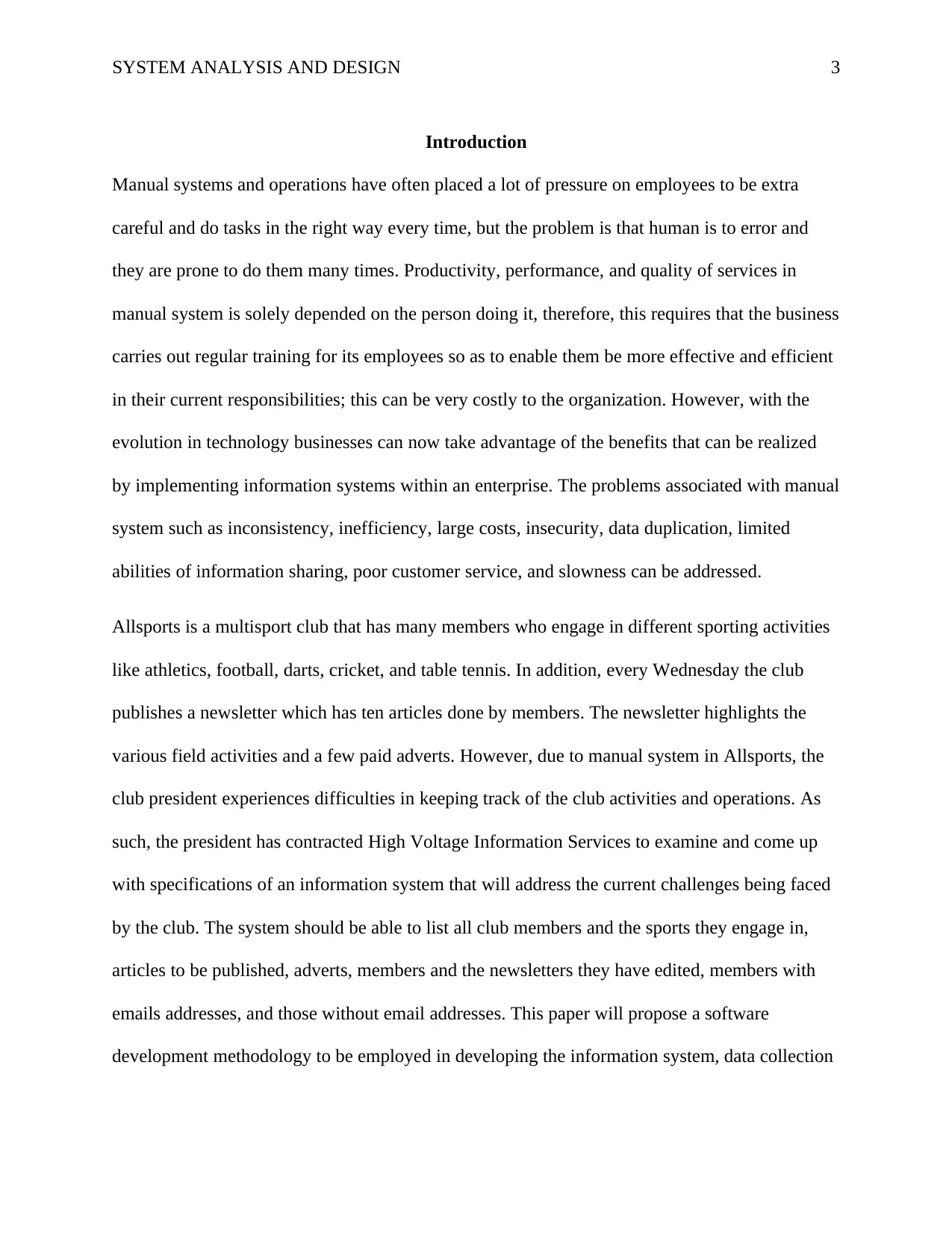
SYSTEM ANALYSIS AND DESIGN 3
Introduction
Manual systems and operations have often placed a lot of pressure on employees to be extra
careful and do tasks in the right way every time, but the problem is that human is to error and
they are prone to do them many times. Productivity, performance, and quality of services in
manual system is solely depended on the person doing it, therefore, this requires that the business
carries out regular training for its employees so as to enable them be more effective and efficient
in their current responsibilities; this can be very costly to the organization. However, with the
evolution in technology businesses can now take advantage of the benefits that can be realized
by implementing information systems within an enterprise. The problems associated with manual
system such as inconsistency, inefficiency, large costs, insecurity, data duplication, limited
abilities of information sharing, poor customer service, and slowness can be addressed.
Allsports is a multisport club that has many members who engage in different sporting activities
like athletics, football, darts, cricket, and table tennis. In addition, every Wednesday the club
publishes a newsletter which has ten articles done by members. The newsletter highlights the
various field activities and a few paid adverts. However, due to manual system in Allsports, the
club president experiences difficulties in keeping track of the club activities and operations. As
such, the president has contracted High Voltage Information Services to examine and come up
with specifications of an information system that will address the current challenges being faced
by the club. The system should be able to list all club members and the sports they engage in,
articles to be published, adverts, members and the newsletters they have edited, members with
emails addresses, and those without email addresses. This paper will propose a software
development methodology to be employed in developing the information system, data collection
Introduction
Manual systems and operations have often placed a lot of pressure on employees to be extra
careful and do tasks in the right way every time, but the problem is that human is to error and
they are prone to do them many times. Productivity, performance, and quality of services in
manual system is solely depended on the person doing it, therefore, this requires that the business
carries out regular training for its employees so as to enable them be more effective and efficient
in their current responsibilities; this can be very costly to the organization. However, with the
evolution in technology businesses can now take advantage of the benefits that can be realized
by implementing information systems within an enterprise. The problems associated with manual
system such as inconsistency, inefficiency, large costs, insecurity, data duplication, limited
abilities of information sharing, poor customer service, and slowness can be addressed.
Allsports is a multisport club that has many members who engage in different sporting activities
like athletics, football, darts, cricket, and table tennis. In addition, every Wednesday the club
publishes a newsletter which has ten articles done by members. The newsletter highlights the
various field activities and a few paid adverts. However, due to manual system in Allsports, the
club president experiences difficulties in keeping track of the club activities and operations. As
such, the president has contracted High Voltage Information Services to examine and come up
with specifications of an information system that will address the current challenges being faced
by the club. The system should be able to list all club members and the sports they engage in,
articles to be published, adverts, members and the newsletters they have edited, members with
emails addresses, and those without email addresses. This paper will propose a software
development methodology to be employed in developing the information system, data collection
⊘ This is a preview!⊘
Do you want full access?
Subscribe today to unlock all pages.

Trusted by 1+ million students worldwide
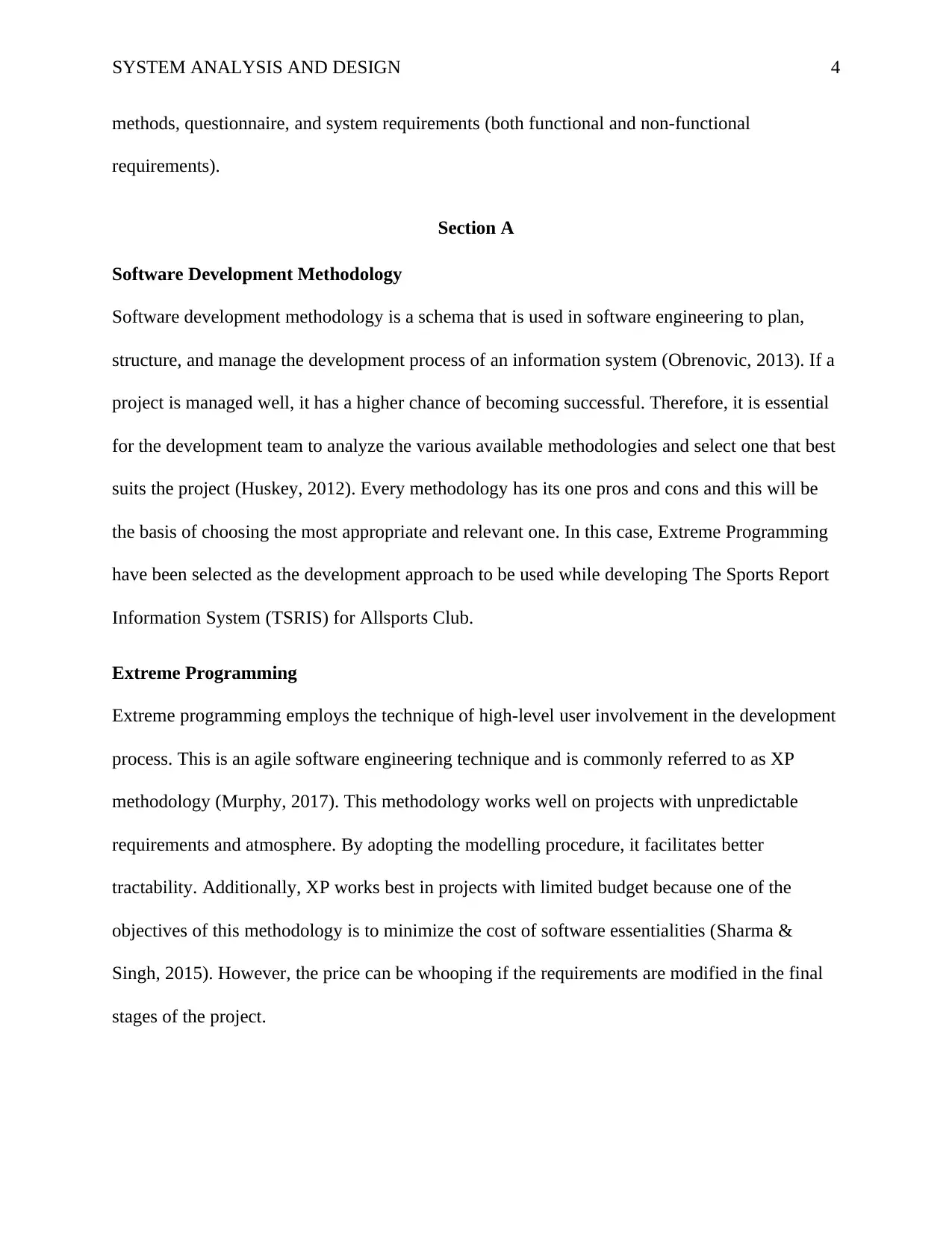
SYSTEM ANALYSIS AND DESIGN 4
methods, questionnaire, and system requirements (both functional and non-functional
requirements).
Section A
Software Development Methodology
Software development methodology is a schema that is used in software engineering to plan,
structure, and manage the development process of an information system (Obrenovic, 2013). If a
project is managed well, it has a higher chance of becoming successful. Therefore, it is essential
for the development team to analyze the various available methodologies and select one that best
suits the project (Huskey, 2012). Every methodology has its one pros and cons and this will be
the basis of choosing the most appropriate and relevant one. In this case, Extreme Programming
have been selected as the development approach to be used while developing The Sports Report
Information System (TSRIS) for Allsports Club.
Extreme Programming
Extreme programming employs the technique of high-level user involvement in the development
process. This is an agile software engineering technique and is commonly referred to as XP
methodology (Murphy, 2017). This methodology works well on projects with unpredictable
requirements and atmosphere. By adopting the modelling procedure, it facilitates better
tractability. Additionally, XP works best in projects with limited budget because one of the
objectives of this methodology is to minimize the cost of software essentialities (Sharma &
Singh, 2015). However, the price can be whooping if the requirements are modified in the final
stages of the project.
methods, questionnaire, and system requirements (both functional and non-functional
requirements).
Section A
Software Development Methodology
Software development methodology is a schema that is used in software engineering to plan,
structure, and manage the development process of an information system (Obrenovic, 2013). If a
project is managed well, it has a higher chance of becoming successful. Therefore, it is essential
for the development team to analyze the various available methodologies and select one that best
suits the project (Huskey, 2012). Every methodology has its one pros and cons and this will be
the basis of choosing the most appropriate and relevant one. In this case, Extreme Programming
have been selected as the development approach to be used while developing The Sports Report
Information System (TSRIS) for Allsports Club.
Extreme Programming
Extreme programming employs the technique of high-level user involvement in the development
process. This is an agile software engineering technique and is commonly referred to as XP
methodology (Murphy, 2017). This methodology works well on projects with unpredictable
requirements and atmosphere. By adopting the modelling procedure, it facilitates better
tractability. Additionally, XP works best in projects with limited budget because one of the
objectives of this methodology is to minimize the cost of software essentialities (Sharma &
Singh, 2015). However, the price can be whooping if the requirements are modified in the final
stages of the project.
Paraphrase This Document
Need a fresh take? Get an instant paraphrase of this document with our AI Paraphraser
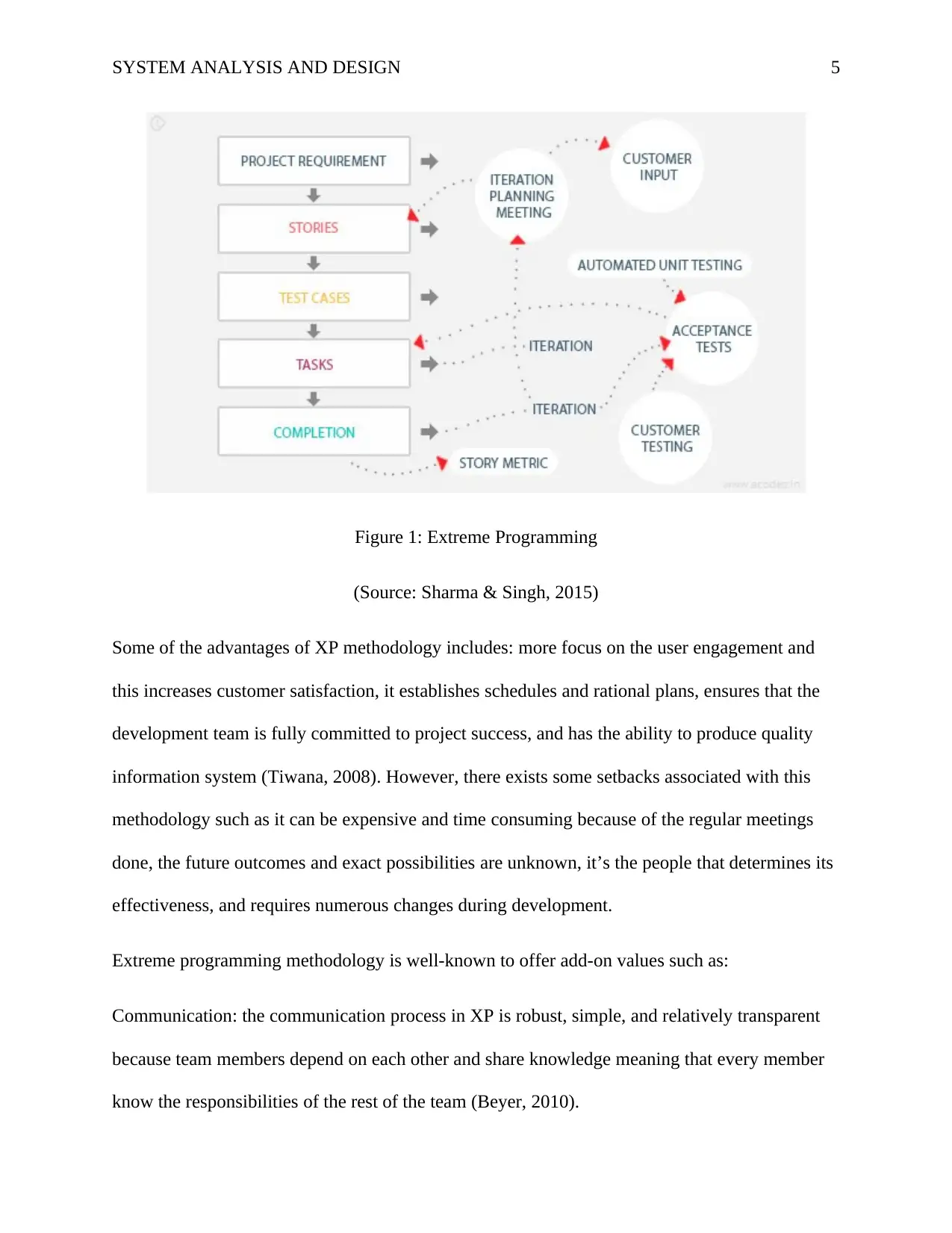
SYSTEM ANALYSIS AND DESIGN 5
Figure 1: Extreme Programming
(Source: Sharma & Singh, 2015)
Some of the advantages of XP methodology includes: more focus on the user engagement and
this increases customer satisfaction, it establishes schedules and rational plans, ensures that the
development team is fully committed to project success, and has the ability to produce quality
information system (Tiwana, 2008). However, there exists some setbacks associated with this
methodology such as it can be expensive and time consuming because of the regular meetings
done, the future outcomes and exact possibilities are unknown, it’s the people that determines its
effectiveness, and requires numerous changes during development.
Extreme programming methodology is well-known to offer add-on values such as:
Communication: the communication process in XP is robust, simple, and relatively transparent
because team members depend on each other and share knowledge meaning that every member
know the responsibilities of the rest of the team (Beyer, 2010).
Figure 1: Extreme Programming
(Source: Sharma & Singh, 2015)
Some of the advantages of XP methodology includes: more focus on the user engagement and
this increases customer satisfaction, it establishes schedules and rational plans, ensures that the
development team is fully committed to project success, and has the ability to produce quality
information system (Tiwana, 2008). However, there exists some setbacks associated with this
methodology such as it can be expensive and time consuming because of the regular meetings
done, the future outcomes and exact possibilities are unknown, it’s the people that determines its
effectiveness, and requires numerous changes during development.
Extreme programming methodology is well-known to offer add-on values such as:
Communication: the communication process in XP is robust, simple, and relatively transparent
because team members depend on each other and share knowledge meaning that every member
know the responsibilities of the rest of the team (Beyer, 2010).
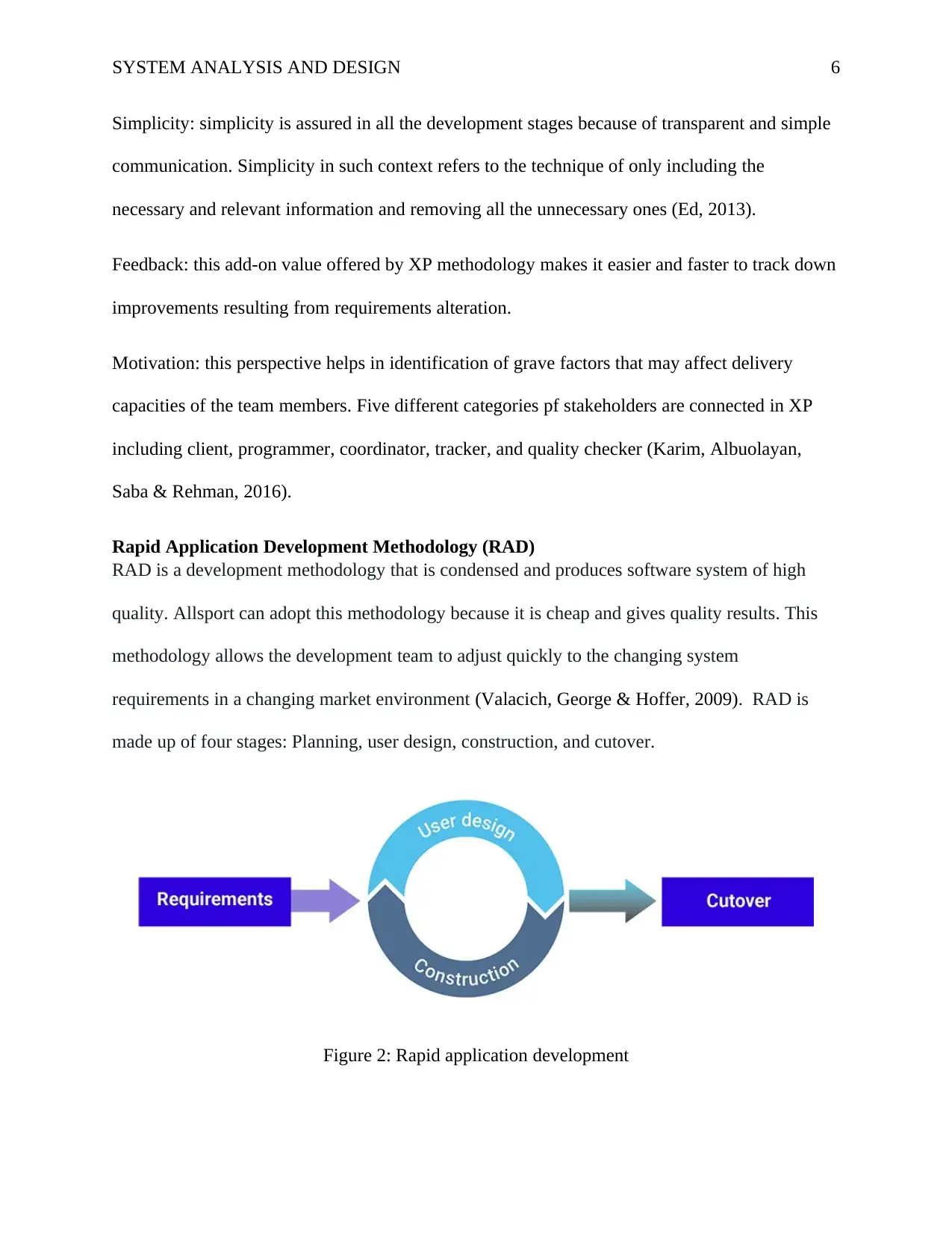
SYSTEM ANALYSIS AND DESIGN 6
Simplicity: simplicity is assured in all the development stages because of transparent and simple
communication. Simplicity in such context refers to the technique of only including the
necessary and relevant information and removing all the unnecessary ones (Ed, 2013).
Feedback: this add-on value offered by XP methodology makes it easier and faster to track down
improvements resulting from requirements alteration.
Motivation: this perspective helps in identification of grave factors that may affect delivery
capacities of the team members. Five different categories pf stakeholders are connected in XP
including client, programmer, coordinator, tracker, and quality checker (Karim, Albuolayan,
Saba & Rehman, 2016).
Rapid Application Development Methodology (RAD)
RAD is a development methodology that is condensed and produces software system of high
quality. Allsport can adopt this methodology because it is cheap and gives quality results. This
methodology allows the development team to adjust quickly to the changing system
requirements in a changing market environment (Valacich, George & Hoffer, 2009). RAD is
made up of four stages: Planning, user design, construction, and cutover.
Figure 2: Rapid application development
Simplicity: simplicity is assured in all the development stages because of transparent and simple
communication. Simplicity in such context refers to the technique of only including the
necessary and relevant information and removing all the unnecessary ones (Ed, 2013).
Feedback: this add-on value offered by XP methodology makes it easier and faster to track down
improvements resulting from requirements alteration.
Motivation: this perspective helps in identification of grave factors that may affect delivery
capacities of the team members. Five different categories pf stakeholders are connected in XP
including client, programmer, coordinator, tracker, and quality checker (Karim, Albuolayan,
Saba & Rehman, 2016).
Rapid Application Development Methodology (RAD)
RAD is a development methodology that is condensed and produces software system of high
quality. Allsport can adopt this methodology because it is cheap and gives quality results. This
methodology allows the development team to adjust quickly to the changing system
requirements in a changing market environment (Valacich, George & Hoffer, 2009). RAD is
made up of four stages: Planning, user design, construction, and cutover.
Figure 2: Rapid application development
⊘ This is a preview!⊘
Do you want full access?
Subscribe today to unlock all pages.

Trusted by 1+ million students worldwide
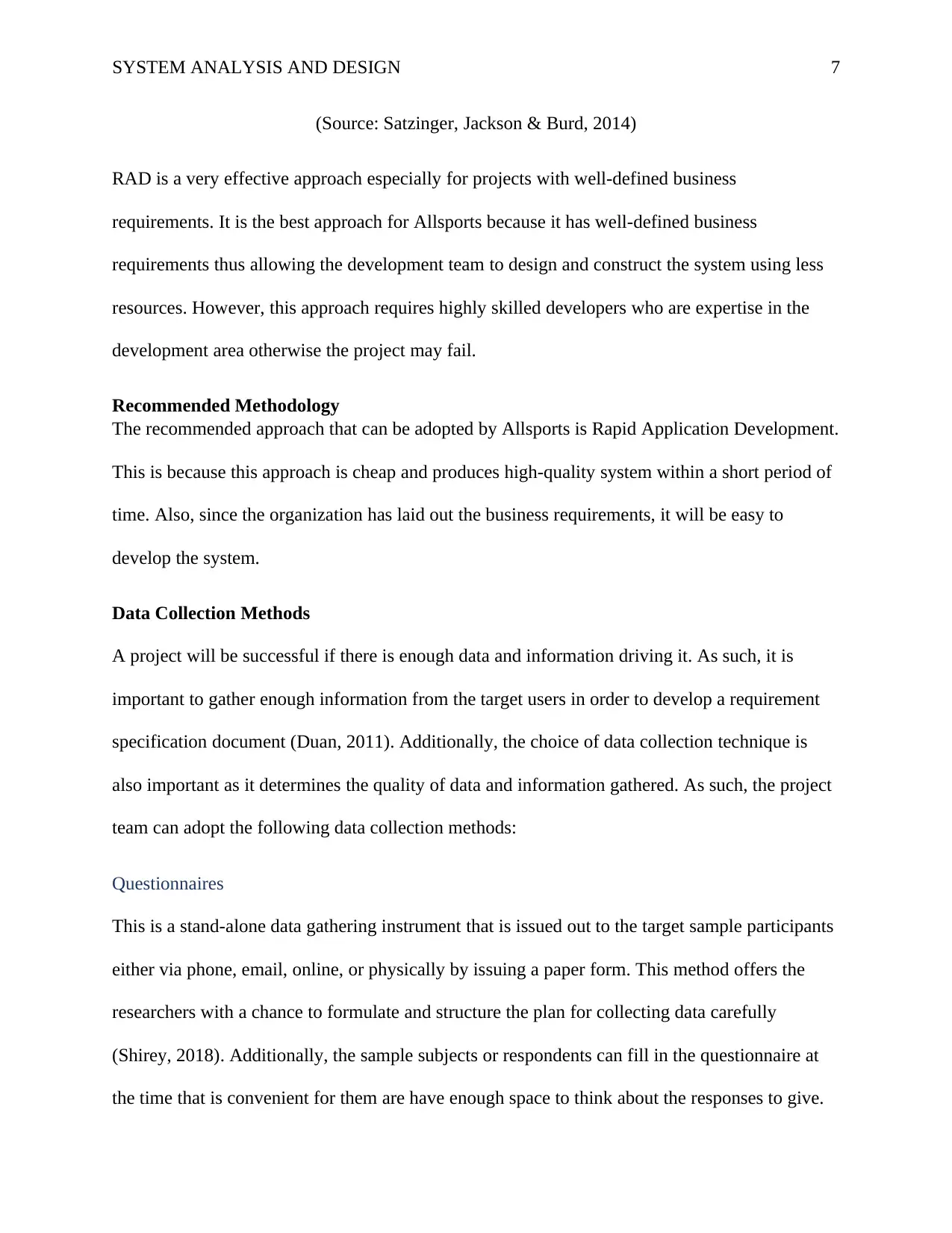
SYSTEM ANALYSIS AND DESIGN 7
(Source: Satzinger, Jackson & Burd, 2014)
RAD is a very effective approach especially for projects with well-defined business
requirements. It is the best approach for Allsports because it has well-defined business
requirements thus allowing the development team to design and construct the system using less
resources. However, this approach requires highly skilled developers who are expertise in the
development area otherwise the project may fail.
Recommended Methodology
The recommended approach that can be adopted by Allsports is Rapid Application Development.
This is because this approach is cheap and produces high-quality system within a short period of
time. Also, since the organization has laid out the business requirements, it will be easy to
develop the system.
Data Collection Methods
A project will be successful if there is enough data and information driving it. As such, it is
important to gather enough information from the target users in order to develop a requirement
specification document (Duan, 2011). Additionally, the choice of data collection technique is
also important as it determines the quality of data and information gathered. As such, the project
team can adopt the following data collection methods:
Questionnaires
This is a stand-alone data gathering instrument that is issued out to the target sample participants
either via phone, email, online, or physically by issuing a paper form. This method offers the
researchers with a chance to formulate and structure the plan for collecting data carefully
(Shirey, 2018). Additionally, the sample subjects or respondents can fill in the questionnaire at
the time that is convenient for them are have enough space to think about the responses to give.
(Source: Satzinger, Jackson & Burd, 2014)
RAD is a very effective approach especially for projects with well-defined business
requirements. It is the best approach for Allsports because it has well-defined business
requirements thus allowing the development team to design and construct the system using less
resources. However, this approach requires highly skilled developers who are expertise in the
development area otherwise the project may fail.
Recommended Methodology
The recommended approach that can be adopted by Allsports is Rapid Application Development.
This is because this approach is cheap and produces high-quality system within a short period of
time. Also, since the organization has laid out the business requirements, it will be easy to
develop the system.
Data Collection Methods
A project will be successful if there is enough data and information driving it. As such, it is
important to gather enough information from the target users in order to develop a requirement
specification document (Duan, 2011). Additionally, the choice of data collection technique is
also important as it determines the quality of data and information gathered. As such, the project
team can adopt the following data collection methods:
Questionnaires
This is a stand-alone data gathering instrument that is issued out to the target sample participants
either via phone, email, online, or physically by issuing a paper form. This method offers the
researchers with a chance to formulate and structure the plan for collecting data carefully
(Shirey, 2018). Additionally, the sample subjects or respondents can fill in the questionnaire at
the time that is convenient for them are have enough space to think about the responses to give.
Paraphrase This Document
Need a fresh take? Get an instant paraphrase of this document with our AI Paraphraser
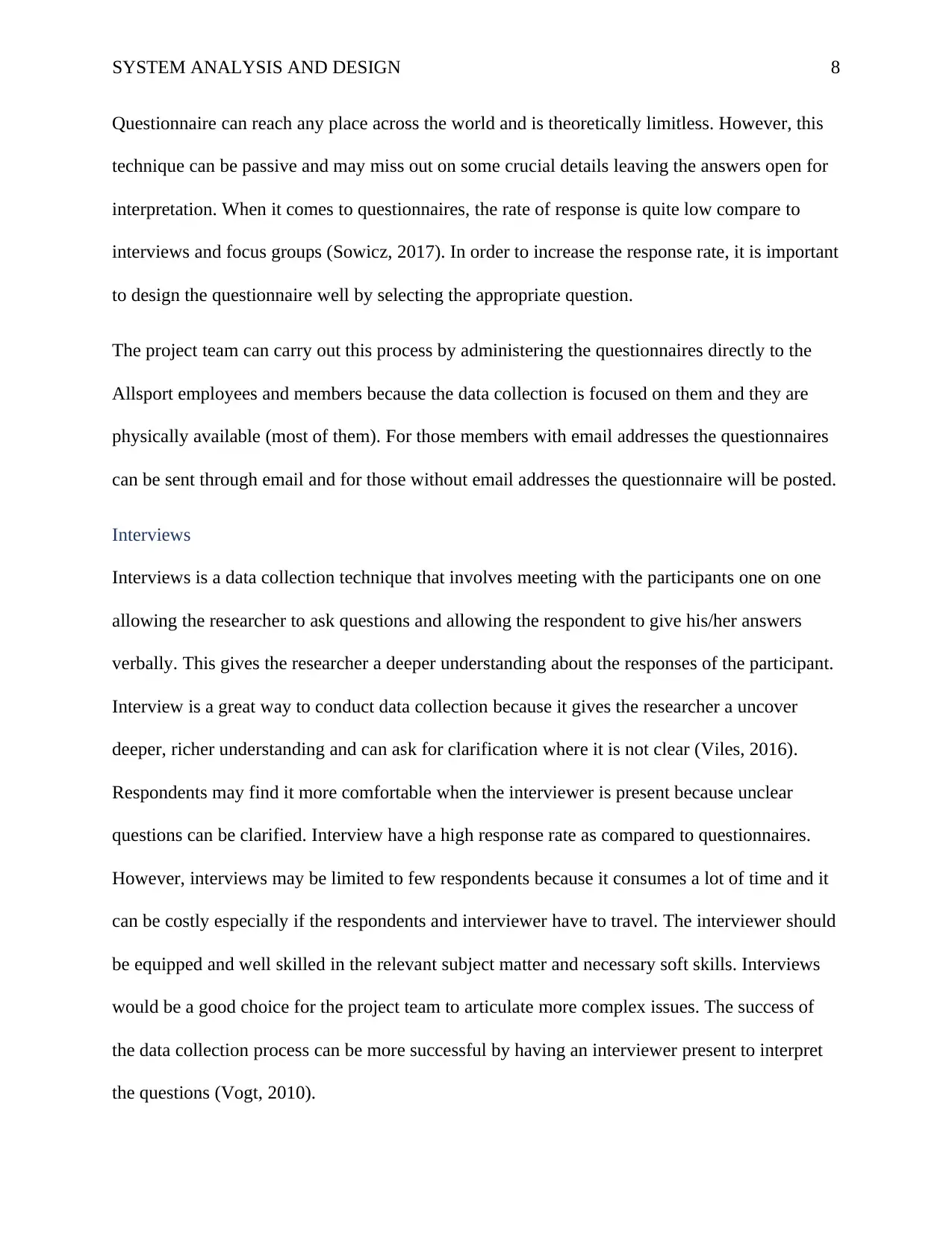
SYSTEM ANALYSIS AND DESIGN 8
Questionnaire can reach any place across the world and is theoretically limitless. However, this
technique can be passive and may miss out on some crucial details leaving the answers open for
interpretation. When it comes to questionnaires, the rate of response is quite low compare to
interviews and focus groups (Sowicz, 2017). In order to increase the response rate, it is important
to design the questionnaire well by selecting the appropriate question.
The project team can carry out this process by administering the questionnaires directly to the
Allsport employees and members because the data collection is focused on them and they are
physically available (most of them). For those members with email addresses the questionnaires
can be sent through email and for those without email addresses the questionnaire will be posted.
Interviews
Interviews is a data collection technique that involves meeting with the participants one on one
allowing the researcher to ask questions and allowing the respondent to give his/her answers
verbally. This gives the researcher a deeper understanding about the responses of the participant.
Interview is a great way to conduct data collection because it gives the researcher a uncover
deeper, richer understanding and can ask for clarification where it is not clear (Viles, 2016).
Respondents may find it more comfortable when the interviewer is present because unclear
questions can be clarified. Interview have a high response rate as compared to questionnaires.
However, interviews may be limited to few respondents because it consumes a lot of time and it
can be costly especially if the respondents and interviewer have to travel. The interviewer should
be equipped and well skilled in the relevant subject matter and necessary soft skills. Interviews
would be a good choice for the project team to articulate more complex issues. The success of
the data collection process can be more successful by having an interviewer present to interpret
the questions (Vogt, 2010).
Questionnaire can reach any place across the world and is theoretically limitless. However, this
technique can be passive and may miss out on some crucial details leaving the answers open for
interpretation. When it comes to questionnaires, the rate of response is quite low compare to
interviews and focus groups (Sowicz, 2017). In order to increase the response rate, it is important
to design the questionnaire well by selecting the appropriate question.
The project team can carry out this process by administering the questionnaires directly to the
Allsport employees and members because the data collection is focused on them and they are
physically available (most of them). For those members with email addresses the questionnaires
can be sent through email and for those without email addresses the questionnaire will be posted.
Interviews
Interviews is a data collection technique that involves meeting with the participants one on one
allowing the researcher to ask questions and allowing the respondent to give his/her answers
verbally. This gives the researcher a deeper understanding about the responses of the participant.
Interview is a great way to conduct data collection because it gives the researcher a uncover
deeper, richer understanding and can ask for clarification where it is not clear (Viles, 2016).
Respondents may find it more comfortable when the interviewer is present because unclear
questions can be clarified. Interview have a high response rate as compared to questionnaires.
However, interviews may be limited to few respondents because it consumes a lot of time and it
can be costly especially if the respondents and interviewer have to travel. The interviewer should
be equipped and well skilled in the relevant subject matter and necessary soft skills. Interviews
would be a good choice for the project team to articulate more complex issues. The success of
the data collection process can be more successful by having an interviewer present to interpret
the questions (Vogt, 2010).
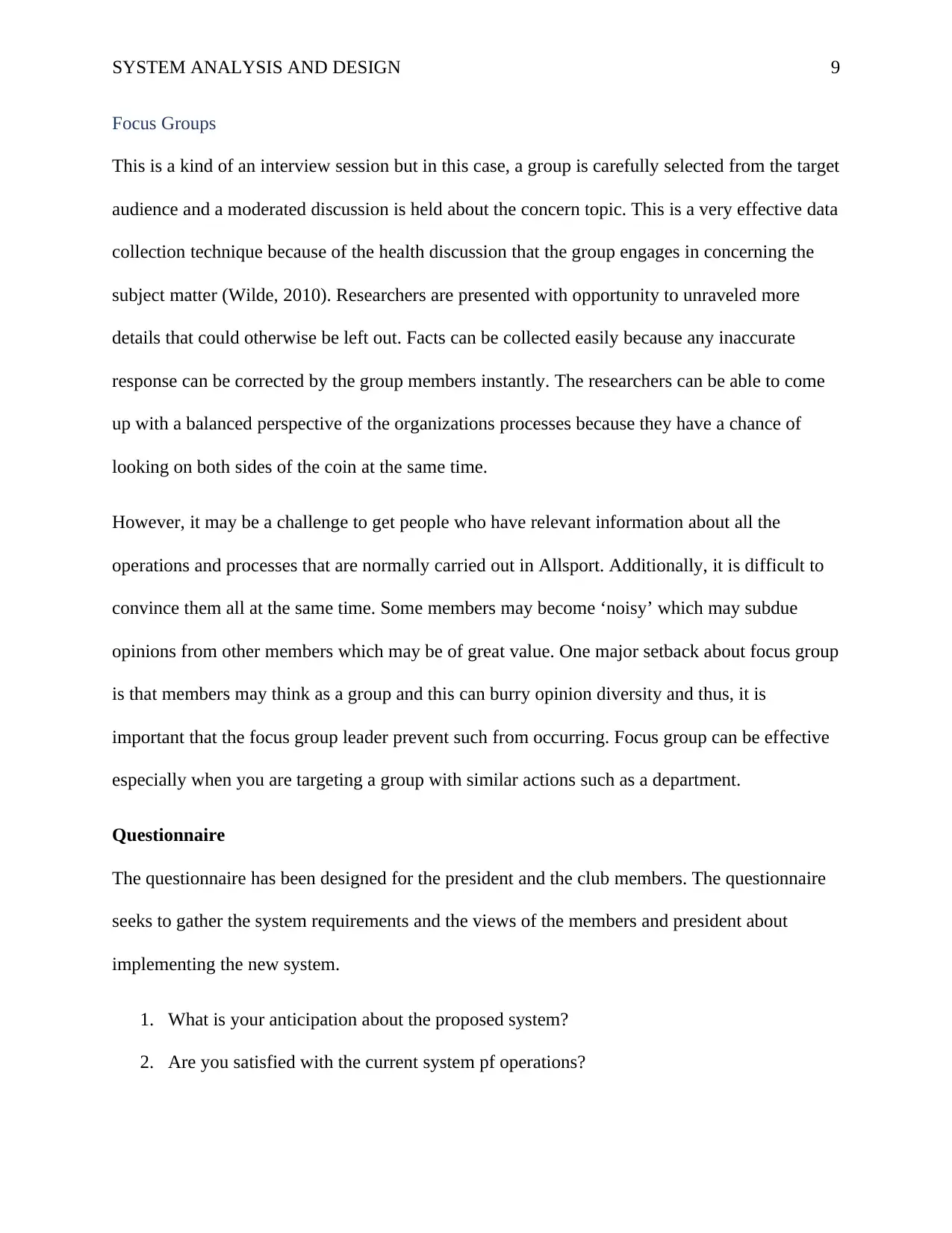
SYSTEM ANALYSIS AND DESIGN 9
Focus Groups
This is a kind of an interview session but in this case, a group is carefully selected from the target
audience and a moderated discussion is held about the concern topic. This is a very effective data
collection technique because of the health discussion that the group engages in concerning the
subject matter (Wilde, 2010). Researchers are presented with opportunity to unraveled more
details that could otherwise be left out. Facts can be collected easily because any inaccurate
response can be corrected by the group members instantly. The researchers can be able to come
up with a balanced perspective of the organizations processes because they have a chance of
looking on both sides of the coin at the same time.
However, it may be a challenge to get people who have relevant information about all the
operations and processes that are normally carried out in Allsport. Additionally, it is difficult to
convince them all at the same time. Some members may become ‘noisy’ which may subdue
opinions from other members which may be of great value. One major setback about focus group
is that members may think as a group and this can burry opinion diversity and thus, it is
important that the focus group leader prevent such from occurring. Focus group can be effective
especially when you are targeting a group with similar actions such as a department.
Questionnaire
The questionnaire has been designed for the president and the club members. The questionnaire
seeks to gather the system requirements and the views of the members and president about
implementing the new system.
1. What is your anticipation about the proposed system?
2. Are you satisfied with the current system pf operations?
Focus Groups
This is a kind of an interview session but in this case, a group is carefully selected from the target
audience and a moderated discussion is held about the concern topic. This is a very effective data
collection technique because of the health discussion that the group engages in concerning the
subject matter (Wilde, 2010). Researchers are presented with opportunity to unraveled more
details that could otherwise be left out. Facts can be collected easily because any inaccurate
response can be corrected by the group members instantly. The researchers can be able to come
up with a balanced perspective of the organizations processes because they have a chance of
looking on both sides of the coin at the same time.
However, it may be a challenge to get people who have relevant information about all the
operations and processes that are normally carried out in Allsport. Additionally, it is difficult to
convince them all at the same time. Some members may become ‘noisy’ which may subdue
opinions from other members which may be of great value. One major setback about focus group
is that members may think as a group and this can burry opinion diversity and thus, it is
important that the focus group leader prevent such from occurring. Focus group can be effective
especially when you are targeting a group with similar actions such as a department.
Questionnaire
The questionnaire has been designed for the president and the club members. The questionnaire
seeks to gather the system requirements and the views of the members and president about
implementing the new system.
1. What is your anticipation about the proposed system?
2. Are you satisfied with the current system pf operations?
⊘ This is a preview!⊘
Do you want full access?
Subscribe today to unlock all pages.

Trusted by 1+ million students worldwide
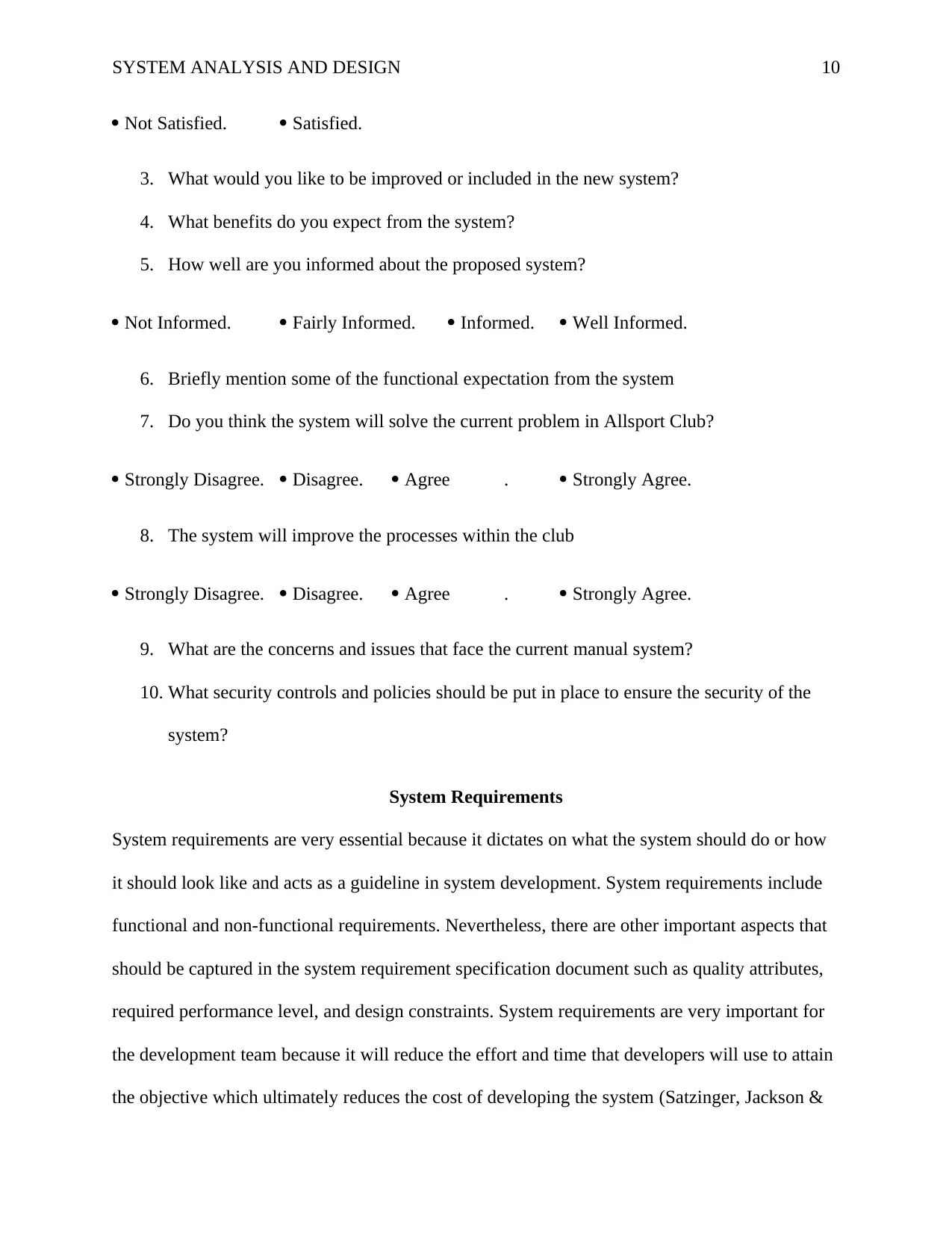
SYSTEM ANALYSIS AND DESIGN 10
Not Satisfied. Satisfied.
3. What would you like to be improved or included in the new system?
4. What benefits do you expect from the system?
5. How well are you informed about the proposed system?
Not Informed. Fairly Informed. Informed. Well Informed.
6. Briefly mention some of the functional expectation from the system
7. Do you think the system will solve the current problem in Allsport Club?
Strongly Disagree. Disagree. Agree . Strongly Agree.
8. The system will improve the processes within the club
Strongly Disagree. Disagree. Agree . Strongly Agree.
9. What are the concerns and issues that face the current manual system?
10. What security controls and policies should be put in place to ensure the security of the
system?
System Requirements
System requirements are very essential because it dictates on what the system should do or how
it should look like and acts as a guideline in system development. System requirements include
functional and non-functional requirements. Nevertheless, there are other important aspects that
should be captured in the system requirement specification document such as quality attributes,
required performance level, and design constraints. System requirements are very important for
the development team because it will reduce the effort and time that developers will use to attain
the objective which ultimately reduces the cost of developing the system (Satzinger, Jackson &
Not Satisfied. Satisfied.
3. What would you like to be improved or included in the new system?
4. What benefits do you expect from the system?
5. How well are you informed about the proposed system?
Not Informed. Fairly Informed. Informed. Well Informed.
6. Briefly mention some of the functional expectation from the system
7. Do you think the system will solve the current problem in Allsport Club?
Strongly Disagree. Disagree. Agree . Strongly Agree.
8. The system will improve the processes within the club
Strongly Disagree. Disagree. Agree . Strongly Agree.
9. What are the concerns and issues that face the current manual system?
10. What security controls and policies should be put in place to ensure the security of the
system?
System Requirements
System requirements are very essential because it dictates on what the system should do or how
it should look like and acts as a guideline in system development. System requirements include
functional and non-functional requirements. Nevertheless, there are other important aspects that
should be captured in the system requirement specification document such as quality attributes,
required performance level, and design constraints. System requirements are very important for
the development team because it will reduce the effort and time that developers will use to attain
the objective which ultimately reduces the cost of developing the system (Satzinger, Jackson &
Paraphrase This Document
Need a fresh take? Get an instant paraphrase of this document with our AI Paraphraser
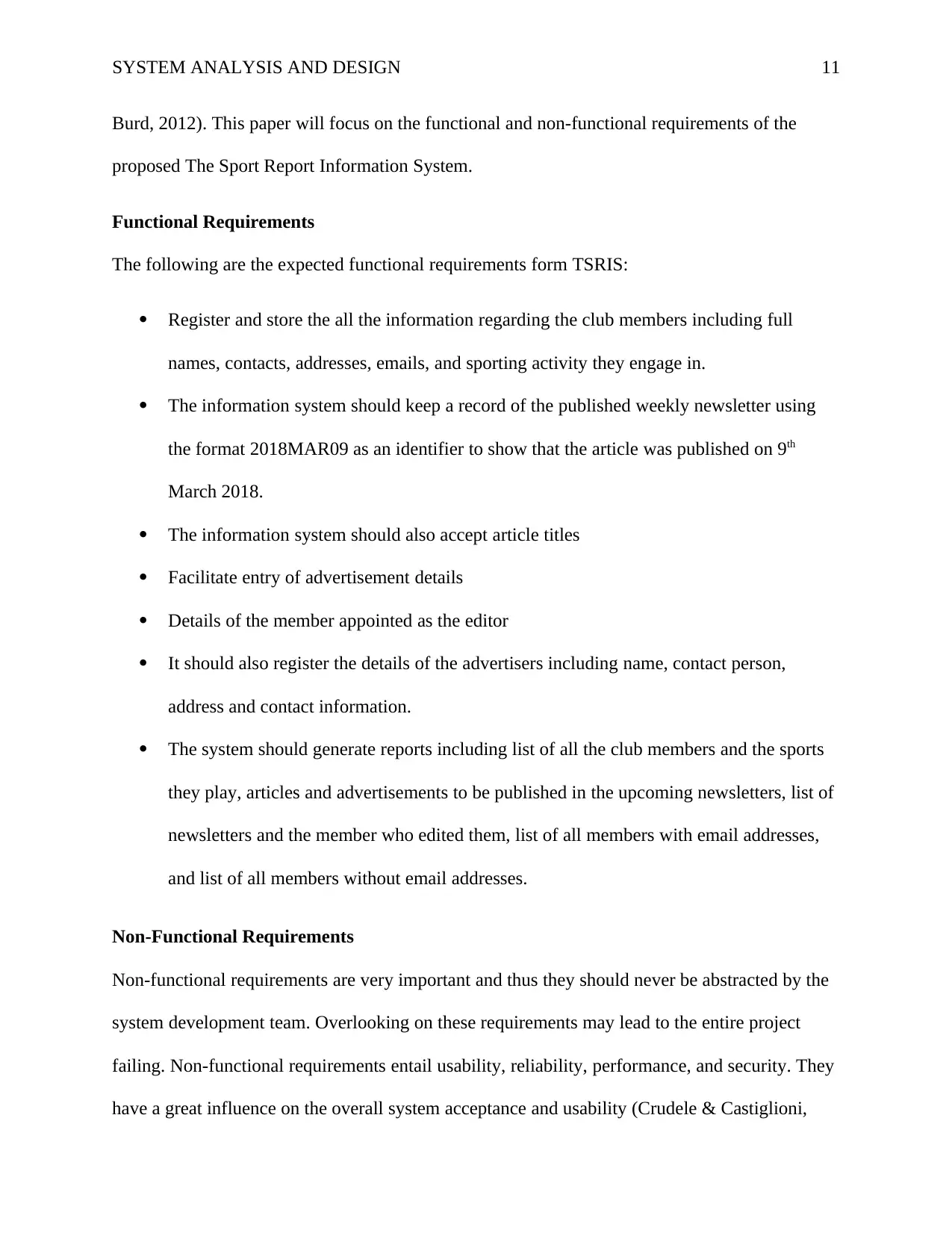
SYSTEM ANALYSIS AND DESIGN 11
Burd, 2012). This paper will focus on the functional and non-functional requirements of the
proposed The Sport Report Information System.
Functional Requirements
The following are the expected functional requirements form TSRIS:
Register and store the all the information regarding the club members including full
names, contacts, addresses, emails, and sporting activity they engage in.
The information system should keep a record of the published weekly newsletter using
the format 2018MAR09 as an identifier to show that the article was published on 9th
March 2018.
The information system should also accept article titles
Facilitate entry of advertisement details
Details of the member appointed as the editor
It should also register the details of the advertisers including name, contact person,
address and contact information.
The system should generate reports including list of all the club members and the sports
they play, articles and advertisements to be published in the upcoming newsletters, list of
newsletters and the member who edited them, list of all members with email addresses,
and list of all members without email addresses.
Non-Functional Requirements
Non-functional requirements are very important and thus they should never be abstracted by the
system development team. Overlooking on these requirements may lead to the entire project
failing. Non-functional requirements entail usability, reliability, performance, and security. They
have a great influence on the overall system acceptance and usability (Crudele & Castiglioni,
Burd, 2012). This paper will focus on the functional and non-functional requirements of the
proposed The Sport Report Information System.
Functional Requirements
The following are the expected functional requirements form TSRIS:
Register and store the all the information regarding the club members including full
names, contacts, addresses, emails, and sporting activity they engage in.
The information system should keep a record of the published weekly newsletter using
the format 2018MAR09 as an identifier to show that the article was published on 9th
March 2018.
The information system should also accept article titles
Facilitate entry of advertisement details
Details of the member appointed as the editor
It should also register the details of the advertisers including name, contact person,
address and contact information.
The system should generate reports including list of all the club members and the sports
they play, articles and advertisements to be published in the upcoming newsletters, list of
newsletters and the member who edited them, list of all members with email addresses,
and list of all members without email addresses.
Non-Functional Requirements
Non-functional requirements are very important and thus they should never be abstracted by the
system development team. Overlooking on these requirements may lead to the entire project
failing. Non-functional requirements entail usability, reliability, performance, and security. They
have a great influence on the overall system acceptance and usability (Crudele & Castiglioni,
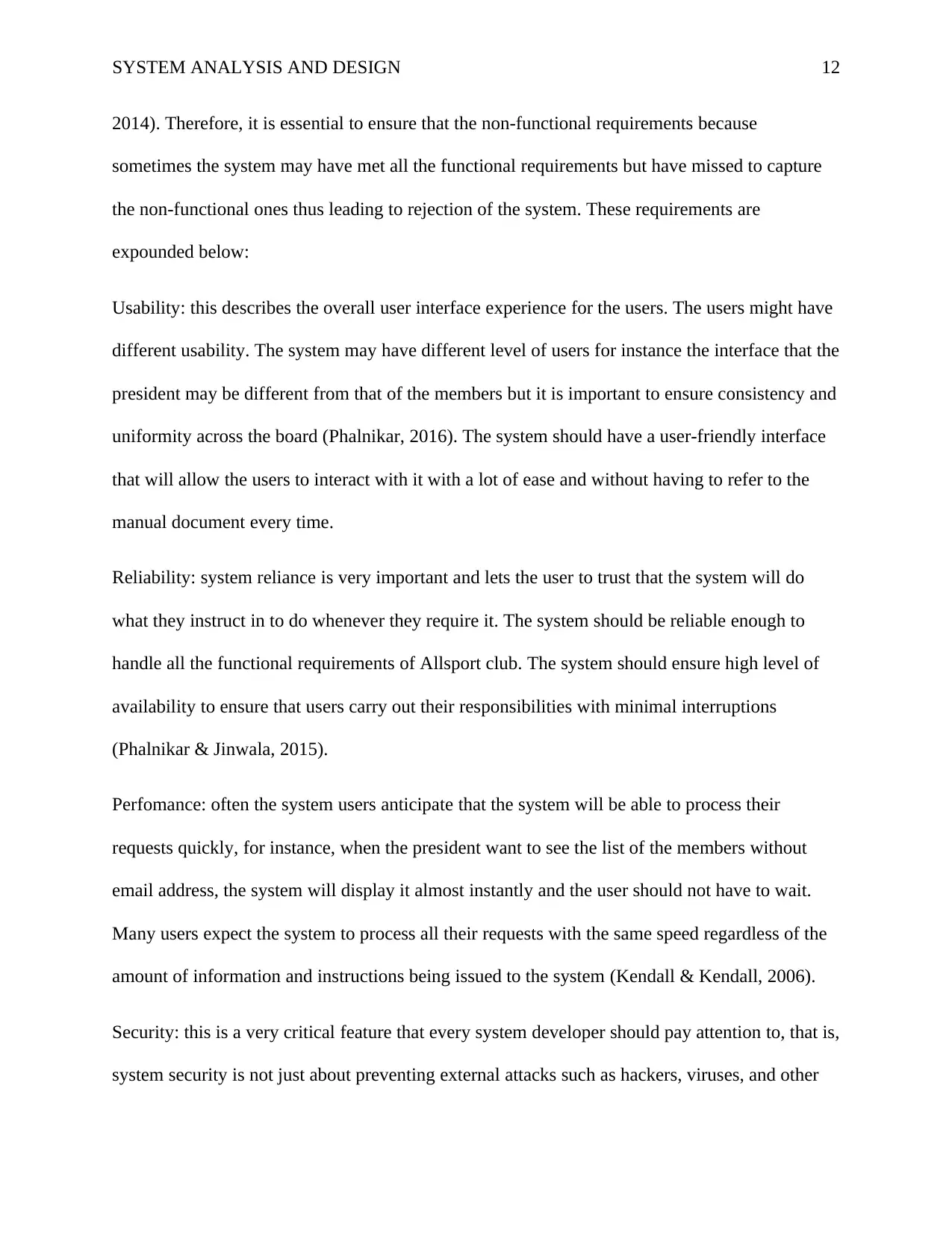
SYSTEM ANALYSIS AND DESIGN 12
2014). Therefore, it is essential to ensure that the non-functional requirements because
sometimes the system may have met all the functional requirements but have missed to capture
the non-functional ones thus leading to rejection of the system. These requirements are
expounded below:
Usability: this describes the overall user interface experience for the users. The users might have
different usability. The system may have different level of users for instance the interface that the
president may be different from that of the members but it is important to ensure consistency and
uniformity across the board (Phalnikar, 2016). The system should have a user-friendly interface
that will allow the users to interact with it with a lot of ease and without having to refer to the
manual document every time.
Reliability: system reliance is very important and lets the user to trust that the system will do
what they instruct in to do whenever they require it. The system should be reliable enough to
handle all the functional requirements of Allsport club. The system should ensure high level of
availability to ensure that users carry out their responsibilities with minimal interruptions
(Phalnikar & Jinwala, 2015).
Perfomance: often the system users anticipate that the system will be able to process their
requests quickly, for instance, when the president want to see the list of the members without
email address, the system will display it almost instantly and the user should not have to wait.
Many users expect the system to process all their requests with the same speed regardless of the
amount of information and instructions being issued to the system (Kendall & Kendall, 2006).
Security: this is a very critical feature that every system developer should pay attention to, that is,
system security is not just about preventing external attacks such as hackers, viruses, and other
2014). Therefore, it is essential to ensure that the non-functional requirements because
sometimes the system may have met all the functional requirements but have missed to capture
the non-functional ones thus leading to rejection of the system. These requirements are
expounded below:
Usability: this describes the overall user interface experience for the users. The users might have
different usability. The system may have different level of users for instance the interface that the
president may be different from that of the members but it is important to ensure consistency and
uniformity across the board (Phalnikar, 2016). The system should have a user-friendly interface
that will allow the users to interact with it with a lot of ease and without having to refer to the
manual document every time.
Reliability: system reliance is very important and lets the user to trust that the system will do
what they instruct in to do whenever they require it. The system should be reliable enough to
handle all the functional requirements of Allsport club. The system should ensure high level of
availability to ensure that users carry out their responsibilities with minimal interruptions
(Phalnikar & Jinwala, 2015).
Perfomance: often the system users anticipate that the system will be able to process their
requests quickly, for instance, when the president want to see the list of the members without
email address, the system will display it almost instantly and the user should not have to wait.
Many users expect the system to process all their requests with the same speed regardless of the
amount of information and instructions being issued to the system (Kendall & Kendall, 2006).
Security: this is a very critical feature that every system developer should pay attention to, that is,
system security is not just about preventing external attacks such as hackers, viruses, and other
⊘ This is a preview!⊘
Do you want full access?
Subscribe today to unlock all pages.

Trusted by 1+ million students worldwide
1 out of 22
Related Documents
Your All-in-One AI-Powered Toolkit for Academic Success.
+13062052269
info@desklib.com
Available 24*7 on WhatsApp / Email
![[object Object]](/_next/static/media/star-bottom.7253800d.svg)
Unlock your academic potential
Copyright © 2020–2025 A2Z Services. All Rights Reserved. Developed and managed by ZUCOL.




